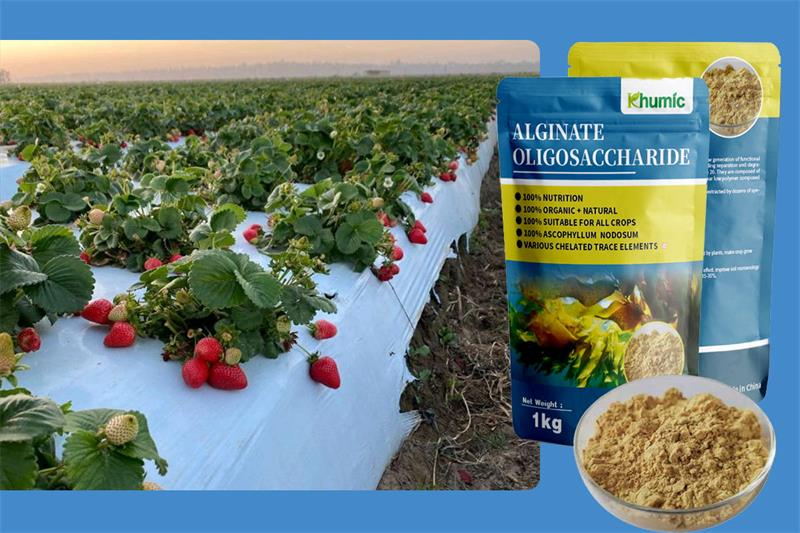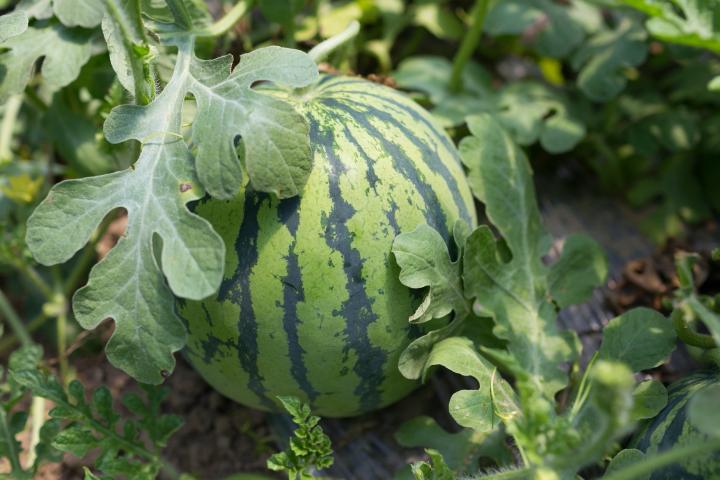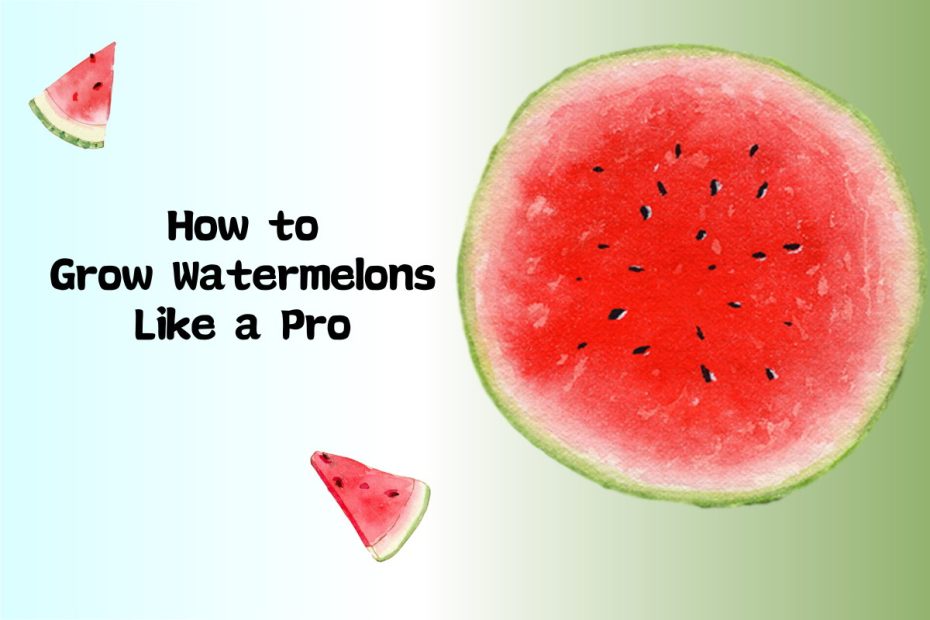Introduction
Do you have a green thumb and a love for juicy, sweet watermelons? Imagine strolling through your garden, picking a perfectly ripe watermelon off the vine, and enjoying its refreshing flavor. Grow watermelons in the garden can be a rewarding experience, but it requires the right knowledge and techniques. And, when growing watermelon plants, understanding the importance of fertilizer is key. Fertilizer is vital in providing essential nutrients that contribute to the healthy growth and development of watermelon crops. In this guide, we’ll walk you through growing delicious watermelons in your garden.
A Guide on How to Grow Watermelons
Choose the Right Watermelon Variety
The first step in growing watermelons is choosing the right variety for your garden. When choosing watermelon seeds, you’ll come across two main types: seedless varieties and seeded varieties. Seedless watermelon is a popular choice among many gardeners. It is convenient and easier to enjoy because it contains no seeds. Seeded watermelon, on the other hand, is loved for its classic taste and traditional appeal. Popular watermelon varieties include Sugar Baby, Crimson Sweet, and Charleston Grey. Choose a variety that suits your growing conditions and preferences to ensure a successful harvest.
Climate and Growing Conditions
Before planting watermelon seeds or seedlings, consider the specific climate and growing conditions in your area. Watermelons thrive in warm climates and full sun. So generally start planting in late spring to early summer when soil temperatures reach 70° F or above. Like its cousin the cantaloupe, watermelon requires 2 to 3 months of heat to produce ripe fruit, but by using plastic mulch to warm soil and floating row covers to trap warm air near plants, gardeners everywhere can Experience the local cultivation of watermelons. Also, be sure to provide enough space for the watermelon vine to extend and grow without restriction.
Preparing the Soil for Planting
Watermelons prefer organic, fertile, well-drained, sandy soil for best growth. Watermelons can be grown in most soils as long as they drain well.
Before growing watermelon seeds or seedlings, take the time to properly prepare the soil. You first need to till the soil at least 8-12 inches and test the soil pH and nutrient levels to determine if any adjustments are needed. Watermelon prefers a slightly acidic environment with a pH between 6.0 and 6.8. Since watermelons grow in large quantities, if your soil is lacking in nutrients, consider using seaweed, compost, organic matter, or well-rotted manure to prepare the planting bed. KHUMIC organic fertilizer improves soil to improve soil texture and nutrition while adjusting soil pH.
Grow Watermelon Seeds or Seedlings
When growing watermelon seeds or seedlings, timing is crucial. Watermelons are a warm-season crop and are not frost tolerant, so wait until all danger of frost has passed before planting. In areas with shorter growing seasons, you can give your plants a head start by starting seedlings indoors 2-4 weeks before the last frost date.
Watermelons can be grown from seeds or transplants. Seeds should be planted 1-2 inches deep, 3-4 feet apart, in 6-8 foot rows. The transplant should have 2-3 mature leaves and a well-developed root system (grafts grow for 6 weeks). Avoid damaging the roots when transplanting to avoid slowing down root establishment and growth. Transplanted melons mature approximately 2 weeks earlier than seed melons.
After planting, cover the seedlings with floating row covers to prevent insects from entering and block warm air near the plants.Caring for Your Watermelon Plant
Once watermelon plants are established, proper watering and fertilizing are essential for their continued growth and development. Watermelon plants require consistent moisture, especially during hot and dry periods, 1-2 inches per week, ensuring the soil remains evenly moist but not waterlogged. Soaker hoses or drip irrigation can be installed to drive water deep into the soil and avoid wetting the leaves. As the fruit matures, reduce watering.
It’s typical for leaves to wilt in the midday sun, but they shouldn’t stay withered until the evening. Watering watermelon vines early in the morning so the leaves can dry before sunset will further help prevent fungal diseases.
When fertilizing your watermelon plants, an early application of a balanced fertilizer with a higher proportion of nitrogen will help promote healthy leaf growth. When plants begin to bloom and produce fruit, switch to a fertilizer higher in phosphorus and potassium to support fruit development.
Get rid of weeds before the vines begin to spread to reduce competition for nutrients and water, since later it will be difficult to move between vines without crushing them. Mulching around plants can help suppress weeds and slow water evaporation.
Watermelon vines have male and female flowers. Don’t be alarmed when some of the male flowers that appear first fall off shortly after opening; the female flowers will bloom after about a week. Female flowers have a small swelling at the base of the flower that remains on the vine to produce fruit. When the vine begins to produce both male and female flowers, remove the row covers.
Avoid direct contact of ripe watermelons with soil to prevent rot and protect the fruit from pests and rodents. When the fruit is about the size of a softball, place it on a bed of straw or cardboard. Placing the fruit on a reflective surface, such as aluminum foil, concentrates heat and speeds ripening. If large animals such as groundhogs find your melons, cover them with a laundry basket weighed down with a few bricks to protect the ripening fruit.Covers and Row Covers
Mulching around watermelon plants can help maintain soil moisture, suppress weeds, and regulate soil temperature:
Organic mulches such as straw or shredded leaves are excellent choices for watermelons because they break down and enrich the soil over time.
Black plastic mulch warms the soil, conserves water, and helps control weeds. Plastic mulch allows for earlier planting and maturation, especially when transplanting. After laying down the mulch, secure the edges with soil and cut holes for seeds or transplants. When using plastic mulch and row covers, seeds or plants can be sown 2-3 weeks before the last frost. Do not use organic mulch (grass clippings, straw, newspaper, etc.) until soil temperature exceeds 75°F. Both plastic and organic mulches help conserve water and control weeds.
Row Covers promote growth and early maturation. Heat caps, plastic tunnels, fabric coverings, and other devices can help protect seedlings and transplants from cold air. Use a thermometer to help determine the temperature under the row cover. Plants grown under row covers require ventilation when temperatures exceed 80°F. The mulch needs to be removed when the plants begin to bloom or when temperatures exceed 90°F. Remove the covering once the weather stabilizes.Control Pests and Diseases
Like any garden crop, watermelon is susceptible to pests and diseases that threaten its health and productivity. Common pests that can affect watermelon plants include cucumber beetles, aphids, and spider mites. Regular monitoring and early intervention can help prevent pest infestations and minimize damage to plants. Additionally, maintaining good garden hygiene, such as removing plant debris and weeds, can help reduce the risk of diseases such as powdery mildew and blight.
Recognize the signs of maturity
As your watermelon plant grows and develops, it’s important to know how to recognize when the fruit is ripe and ready for harvest. When determining the ripeness of your watermelon, look for visual and tactile clues. Watermelons are ready to harvest when they turn from bright green to dark green. The rind of a ripe watermelon usually has a dull, dull appearance, while the underside (where the watermelon rests on the ground) may be discolored. Another indicator of ripeness is the sound the watermelon makes when tapped – a ripe watermelon will make a low, hollow sound.

Harvesting and Storing Watermelons
Harvesting watermelons when they are at their peak ripeness ensures you enjoy the best flavor and texture of the fruit. Use a sharp knife or scissors to cut the watermelon from the vine, leaving a few inches of stem attached to the fruit. Handle harvested watermelons carefully to avoid bruising or damaging the skin. If you have a lot of watermelons, you can store them in a cool, dry place or in the refrigerator to extend their shelf life and preserve their freshness. Add fresh watermelon to salads, and smoothies, or just enjoy it on its own and enjoy the fruits of your labor.
Tools
- Tillage tools, mulch film, soaker hose or drip irrigation system, straw or cardboard beds
Materials
- Watermelon seeds or watermelon seedlings, KHUMIC fertilizer, sandy soil with a pH of 6.0-6.8
FAQ Troubleshooting
Despite your best efforts, you may still encounter challenges when growing watermelons.
For example, melon aphids can quickly colonize vines, so check the undersides of leaves daily. If you find aphids, treat them with insecticidal soap. Spotted and striped cucumber beetles attack vines and spread bacterial wilt, causing the vines to collapse from recovery. Treat adult beetles with a rotenone or pyrethrum insecticide; apply at dusk to avoid harming bees.
For example, yellowing leaves may be a sign of nutrient deficiencies, overwatering, or insect infestation. Monitor your facility closely and resolve any issues promptly to prevent them from escalating. Blossom end rot is another common problem affecting watermelon plants, often caused by a calcium deficiency or inconsistent watering. Adjusting watering schedules and ensuring proper soil calcium levels can help prevent bloom rot and promote healthy fruit development.
| Insect | Identification | Control |
|---|---|---|
| Aphids | Green or black soft-bodied insects that feed on the undersides of leaves. Causes leaves to become shriveled and curled, potentially spreading viral diseases. The secreted honeydew makes plants appear shiny, moist, or slimy. | Use insecticidal soaps or a strong water stream to dislodge insects |
| Cucumber Beetles | Adults are striped or spotted and feed on leaves and vines, reducing plant vigor. They spread bacterial diseases. The larvae burrow into roots and stems, causing the plant to wilt and die. | Application of chemicals at first appearance is needed to control pests. |
| Disease | Symptom | Control |
| Powdery Mildew | Infected plants develop white to gray, talc-like spots or patches on leaves and stems, which become larger and more densely packed as the disease progresses, spreading up and down the length of the plan | Just mix milk and water and spray your plants thoroughly. Or use a baking soda sanitizer solution |
| Wilt Diseases | Wilted leaves on one or more vines. Plants often die. Streaks, slime formation or gummy exudates are visible on the stems, and the disease is caused by different pathogens. | Identify causal disease. Treat disease as recommended once identified. |
| Virus | Leaves are light green, mottled, malformed, dwarfed, and curled. Early infection affects fruit shape and flavor, An aphid transmitted disease. | Control aphids. Destroy severely infected plants. |
Conclusion
Grow watermelons are a delightful experience that allows you to taste the taste of freshly harvested fruit. From refreshing watermelon salads to thirst-quenching smoothies, there are countless ways to enjoy the taste of homegrown watermelon. By following the tips outlined in this guide, considering using KHUMIC organic fertilizer, building plant resistance, soil fertility, and regulating soil pH, you can grow delicious watermelons in your garden and enjoy a bountiful harvest.
FAQs
Will crossing watermelon with other vine crops in the garden result in low sugar content?
Won’t. Although watermelon, squash, and cucumber varieties will cross with each other, the effect of this cross-pollination is not obvious unless the seeds are saved and planted the following year. Wilted vines, high temperatures, or a short growing season in the far north may cause poor melon flavor.
What can be done to prevent watermelon stunting and end rot?
This condition is similar to tomato blossom end rot and is caused by extremely dry weather during the melon growing period. This may be exacerbated by continued deep hoeing, intensive tillage, or poor irrigation. Covering plants with black plastic wrap can help reduce this problem.
How long does it take for watermelons to grow?
Watermelons typically take 80-90 days to mature from the time they are planted.
How often should watermelon plants be watered?
Watermelon plants require constant watering, especially during hot and dry periods. Aim for deep watering once or twice a week.
What is the best way to store harvested watermelons?
Store harvested watermelon in a cool, dry place or in the refrigerator to preserve its freshness and flavor.
